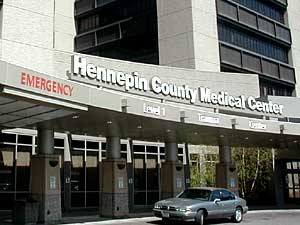June 17, 2005
 |
| Officials at the Hennepin County Medical Center fear they might bear the brunt of any cuts to Medicaid. HCMC is a public safety net hospital that serves a disproportionate number of people on the program. (MPR file photo) |
St. Paul, Minn. — President Bush wants to cut billions of dollars from Medicaid, the health benefit program for low income and disabled people. He says it's time to rein in what has become an enormously expensive program. Medicaid spending tops more than $300 billion a year. That's up about 50 percent in the past five years.
The growth isn't expected to slow down. The Congressional Budget Office says unless Medicaid spending rates are changed, the program will cost nearly $600 billion by 2012.
Initially, Bush proposed cutting $60 billion over 10 years. But that proposal met with fierce opposition from states and health care activists. Congress eventually reduced the president's proposed cuts to $10 billion over five years.
Still, a $10 billion cut is a substantial one that is likely to affect most recipients in most states, including Minnesota. In Minneapolis, officials at Hennepin County Medical Center fear they might bear the brunt of any cuts. HCMC is a public safety net hospital that serves a disproportionate number of people on Medicaid.
Dr. Michael Belzer, HCMC's medical director, says his hospital is often the first to feel any state or federal budget cuts. For example, when Minnesota lawmakers pared back state health programs in 2003, he says HCMC saw a 38 percent increase in patients who had no insurance or limited coverage the next year. Those patients cost the hospital an extra $31 million.
If the proposed federal cuts go through, Belzer estimates that HCMC will lose another $8 million to $10 million. He says the hospital can't continue to sustain those kinds of cuts.
"Medicaid is a very, very, very important payer to us, and allows us to carry on our mission of taking care of the disadvantaged and the vulnerable and poor," says Belzer. "So any cuts to Medicaid, either at the federal level or at the state level, would be a very serious problem for us."
So far, Belzer has heard few specifics on the proposed cuts. A lot of speculation centers on the future of an accounting loophole that some states use to qualify for additional federal Medicaid money.
It's called an intergovernmental transfer, and Minnesota uses it to compensate hospitals like HCMC that serve a lot of people on Medicaid. The Bush administration has proposed eliminating the transfers to save money.
The funding situation also poses a dilemma for state officials like Christine Bronson, who directs Minnesota's Medicaid program, known as Medical Assistance.
Bronson says it's true that like the rest of the nation, Minnesota's Medicaid budget has ballooned in recent years. But she's not convinced that cutting the program will fix the problem.
"I certainly understand that money is the problem. It's the problem in all states to fund Medicaid. It's a problem at the federal level to fund Medicaid," says Bronson. "But though it's the most evident problem, solving that on paper on a budget sheet -- either at the state Legislature or in Congress -- is not a sufficient solution for Medicaid clients."
A little more than 10 percent of Minnesota's population uses Medicaid. But the program is projected to gobble up 24 percent of the state's operating funds in 2006 and 2007. That would put Medicaid spending in Minnesota on nearly an equal footing with state spending on K-12 education.
Bronson says most of the increased cost is due to growth in the Medicaid rolls.
The Department of Human Services has recorded increases in all categories of Minnesotans served by Medicaid, from children and families to seniors and the disabled.
"The current thinking is that much of the increase in people seeking assistance from publicly funded health care is an erosion in the private market of employer-based coverage," says Bronson. "So a lot of people who may at one time have had an opportunity to get health care through their employer simply don't have those options, or can't afford the high cost-sharing that their employer might be offering."
State statistics appear to back up that phenomenon. Last fall, a joint study by the University of Minnesota and the state detected a jump in the number of uninsured Minnesotans from 2001 to 2004. Medicaid researcher Lynn Blewett says during that time period, the uninsured rate rose from 5.4 percent to 6.7 percent.
"I think this is going to be a new struggle for Minnesota," says Blewett. "We've always been in the top two or three in number of uninsured. We still rank very high on coverage, but I think that's going to change."
More than 400,000 Minnesotans don't have health insurance. Some fear that number could go up if the Medicaid cuts include forcing people from the program.
Blewett suspects that as the first baby boomers retire and begin qualifying for public benefits, the number of uninsured will grow even more. She says that will put an enormous strain on the public health system and will likely force even more cuts to programs like Medicaid.
"You can see the bubble moving. You can see what's coming, and to just cut payments to providers or cut people off the program, it doesn't do anything to those trends and that bubble moving," says Blewett.
A special Medicaid commission is being formed to recommend ways to cut $10 billion from the program. The commission has until September to come up with its suggestions.
Democrats have refused to take part in the panel and the nation's governors declined an invitation too, because they're working on a counterproposal.
The governors' plan is still in the works. But the group has long argued that any cost savings in Medicaid must be combined with ways to help people avoid needing assistance in the first place.






